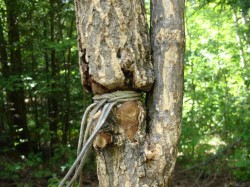Trees are made to sway in the breeze. They need to, really. Trees and wind have been doing this dance for a long time, and the trees seem to have learned their steps. Just watch them: they move a lot and they do it well. And as it turns out, trees that are free to sway in the breeze grow better and live longer than trees staked and tied in place.
Sure we’re all quick to note that the woods are cluttered with broken branches and fallen trees – evidence of wind damage to trees. But it turns out that lesser-force winds can stimulate tree growth. Trees – especially planted trees – actually benefit from the bending and pulling and compressing of branches, stems, and roots as the tree follows the lead of these lesser winds. Staked and tied trees, however, grow abnormally, and they often die by a form of tie-wire strangulation.
So why do you see so many staked and tied trees in the planted environment? There was a time when the practice was encouraged because it was thought to help support and thereby establish the newly planted tree and even protect it from vandalism and mechanical injury. Studies on tree growth and the experience of seeing what becomes of far too many staked and wired trees have led to new advice.
In short, most newly planted trees do not need to be staked and wired, and many suffer from it. Most balled and burlapped trees, for example, have enough of a root ball that they are bottom-heavy and can stand upright on their own when first planted. Such trees need some wind-caused movement to stimulate growth and proper root and stem development. Tying them in place often results in odd growth patterns and troublesome stem conditions from the temporary restriction against movement. Studies have shown that trees staked and wired tend to put their energy into growing taller but not wider, especially near the ground. This is not good. It leads to a lack of proper stem taper and poor root development. Such trees outgrow their own ability to support themselves and eventually they break or fall over. Trees free to move, on the other hand, tend to be shorter and have larger diameters, better stem form, and stronger root systems. They last longer.
Worse yet, in many cases, the ties are never removed and the tree becomes girdled by them. That is, as the stem increases in girth, the ties do not expand; instead, they restrict and kill cells in the cambium – that all-important layer of actively dividing cells just beneath the bark – and the vascular system is cut off. The tree cannot send water and nutrients from the roots to the stem, branches, and leaves, nor can it send carbohydrates from the leaves to the roots. The result is oozing swellings and premature death.
But there are a few circumstances where it pays to stake and tie new plantings. If you are planting trees in open, extremely windy sites, or if your tree is tall with minimal or bare root systems (no root ball with soil), or if you are planting in exceptionally shallow and poor soils, it may in fact be worth staking and tying. When it is called for, however, staking and tying must be done properly, or it will be for naught.
If you do stake and tie your new tree, drive the stakes outside the root ball and tie the tree to the stakes using a wide, flexible material. Usually, two stakes opposite each other will suffice, but a third stake may be needed for especially unstable plantings. Discarded inner tubes or nylon stockings serve well as ties. If you use wire, don’t attach the wire directly to the tree. Instead, run the wire inside a section of old garden hose where it connects to the tree. Tie as low as possible – no more than two-thirds of the main stem height – and allow for some movement of the stem. Monitor your tree. Check the ties periodically to see that they are attached well but not too tightly and that no abrasion wounds are occurring. Adjust as necessary.
Most importantly, remove the ties at the beginning of the second growing season after planting. If you stake and tie your new tree this summer, remove the ties next spring. Put it on the calendar. For planted trees likely to be bumped by lawnmowers or the like, the stakes can be left in place after the ties are removed to provide additional protection. This practice will allow your tree to become established in the site but will leave it free to move with the breeze and become a sturdy, wind-firm tree.



Discussion *